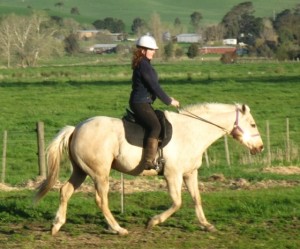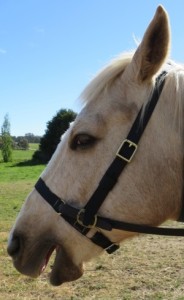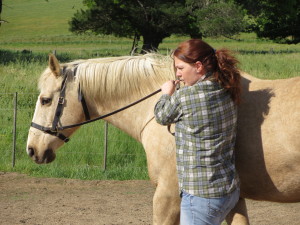Cowboy’s Cause
… the Catalyst for a Creation
‘Cowboy’ the Quarter Horse had much to say.
He was reactive to touch and often stretched his neck, head and jaws in an effort to relax his bulky, stiff muscles. With his stiff, goose-step movement came mental tension, which he would try to release with lots of fiddling, ‘playing’ and mouthing things. Much of his play was not joyful, but actions to release anxiety.
Cowboy was on loan to Angela on the condition that she never introduce a bit to his mouth. Instead, Angela would work on developing the skills and relationship necessary to ride bitless safely. Without enough preparation, Cowboy would buck at the feel of the girth on his tight muscles, and even on a good day, Cowboy was so stiff that he was not a comfortable ride.
a bit to his mouth. Instead, Angela would work on developing the skills and relationship necessary to ride bitless safely. Without enough preparation, Cowboy would buck at the feel of the girth on his tight muscles, and even on a good day, Cowboy was so stiff that he was not a comfortable ride.
The rope halter had been an adequate riding tool for learning some basics at the walk, but it was inadequate riding tool for learning anything more. Signals from the halter were too coarse, too vague and too late, creating delayed responses and over-corrections. Cowboy could neither hold a straight line nor make a balance circle. It was hard for Cowboy to make anything but coarse movements, and although he was never punished or pressured, Cowboy could be wrong for too long, which did not help his confidence in his rider’s communication, or his balance.
Angela tied reins to the sides of a flat headstall, but found it nearly as vague as the rope halter. I disliked the action of his owner’s bitless bridle as there was too much variation in the contact. It also had the potential to be too tight with contact, especially if Angela accidentally pulled on both reins at the same time. Of course, any severe form of bitless bridle or hackamore, such as with cranks, buttons or lever actions, was out of the question.
Our next step was to alter his bitless bridle so that it resembled a cavesson noseband with reins attached on the sides. The difference in Cowboy’s way of going was immense: he now understood what we wanted him to do, how we wanted him to carry himself and where we wanted him to place his feet. We were able help him find his center of gravity while carrying the rider to help him be more physically balanced, which enabled him to relax. Being balanced and calm helped him move more freely, which built his confidence and improved his physical flexibility. He looked so much happier!
However, there was still one problem…
In order to develop the best relationship and respect Cowboy’s physical capacity, Cowboy needed freedom to express himself with his jaws. But, Cowboy could hardly open his mouth. We wanted to allow him to stretch and twist his jaws in order to express and release his tension, and to yawn when he assimilated new information. These behaviours would help him greatly. Playing with objects makes life more interesting and improves confidence, but this was not possible in the adjusted bitless bridle. Grazing could help him relax and have purpose on a ride out, but he was hardly able to eat.
Cowboy needed a bitless bridle that would not limit his breathing or jaw movement, or put extreme pressure on any part of his head, yet still allow clear and consistent aids. Pared down to its functional components only, Cowboy would not have unnecessary equipment to carry, or become hot and uncomfortable wearing. From these criteria I designed the Gydle.
The Gydle was more successful than we could have imagined. Now Cowboy could not only follow clear aids, which helped him move better, he could stretch his jaws as much as he needed. Sometimes he would stretch his jaws to release tension, or to mouth or yawn when he comprehended new things. Other times he would twist his jaws, showing us he was anxious. He could easily use his mouth to pick up and play with interesting objects. Angela did not even need to adjust the headgear when allowing Cowboy some grazing time on her rides out.
Angela was now happy to maintain a steady rein contact, confident that she was not hurting Cowboy. this enabled her to give clearer rein aids, which helped Cowboy to understand quickly. She was able to use his head and neck position to improve his centre of gravity and weight distribution. this helped Cowboy carry Angela more efficiently and allowed his limbs to move more freely. He became more comfortable to ride and his face took on a soft, relaxed expression, as did Angela’s!
With Angela and Cowboy happier and going so much better in the Gydle, I set about trying it on many of my students’ horses. All the horses went as well, or better, that in their usual bridles or halters, and we all agreed they appeared happier. I tried the Gydle on my new horse, Barney, who was still quite herd-bound. For the first time, he did not power-walk home. Instead, he had a more natural head carriage, which allowed him to walk at a relaxed, forward pace, without the desire to trot or leap. I have never had trouble controlling Barney’s undesirable behaviour through the Gydle; he has actually settled more quickly without the added surprise or fear of the bit to deal with. The Gydle has really helped Barney become a much more confident, happy and reliable partner and mount.
My students helped me in developing the Gydle by using my prototypes to ride dressage, jumping, trail riding, as well as green and difficult horses. Thanks to Cowboy, many more horses and riders are happy now they have a Gydle to ride in

